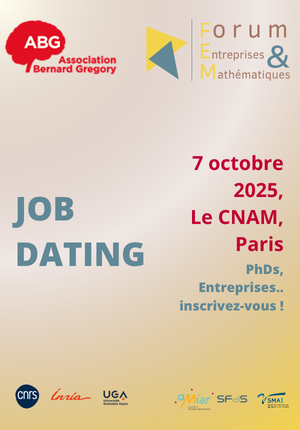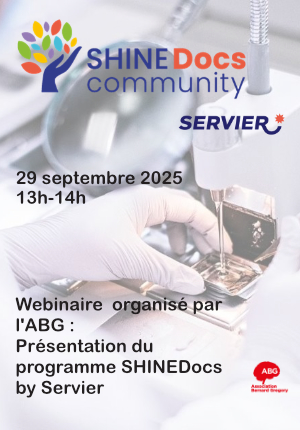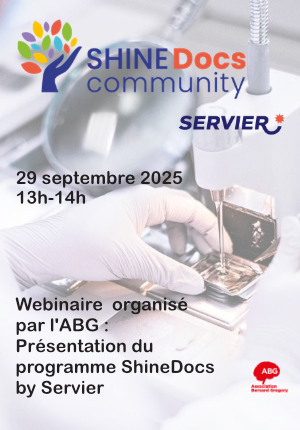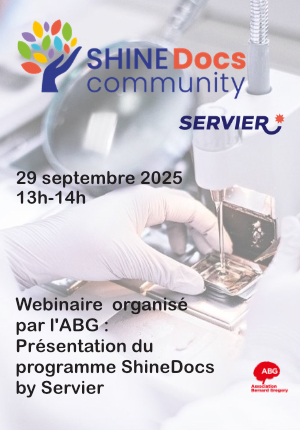Une approche computationnelle pour l'étude de l'évolution du paysage métabolique dans le développement du cancer // A computationnal approach to investigate the evolution of the metabolic landscape in cancer development
|
ABG-132591
ADUM-66634 |
Sujet de Thèse | |
| 20/06/2025 |
Université Grenoble Alpes
LA TRONCHE - Auvergne-Rhône-Alpes - France
Une approche computationnelle pour l'étude de l'évolution du paysage métabolique dans le développement du cancer // A computationnal approach to investigate the evolution of the metabolic landscape in cancer development
- Biologie
biology théorique, métabolisme énergétique cellulaire, réseau booléen, paysage de Waddington
theoretical biology, cell energy metabolism, boolean networks, Waddington landscape
theoretical biology, cell energy metabolism, boolean networks, Waddington landscape
Description du sujet
Il est communément admis dans la communauté scientifique que les mutations sont les moteurs du développement du cancer. Récemment, une théorie alternative à la théorie de mutation somatique (SMT) a été proposée, postulant que la dérégulation locale de l'environnement tissulaire pourrait également être responsable de l'émergence et de l'évolution de la maladie. Cette théorie est connue sous le nom de théorie du champ d'organisation tissulaire (TOFT) (Sonnenschein et Soto, 2016). Par conséquent, les deux théories proposent une origine différente du cancer et de son évolution, sans toutefois s'opposer (Bedessem et Ruphy, 2015).
Dans ce projet, nous proposons d'aborder cette question à l'aide de modèles computationnels pour lesquels notre équipe (BCM) a développé une expertise. Dans une étude récente, axée sur la modélisation du métabolisme cellulaire au cours de la croissance et du développement tumoraux, nous avons montré que l'adaptation métabolique cellulaire spontanée aux conditions changeantes de l'environnement suffit à expliquer l'émergence du phénotype Warburg, classiquement décrit comme une caractéristique du cancer (Jacquet et Stéphanou, 2022). Nos simulations montrent que, contrairement à l'idée reçue, l'effet Warburg n'est pas une propriété exclusive du cancer induit (ou favorisé) par des mutations, mais peut également être un effet contextuel et transitoire émergent qui ne dépend que des conditions environnementales locales (Jacquet et Stéphanou, 2023). Ceci est en accord avec des travaux récents sur le cancer qui démontrent l'importance de la plasticité cellulaire, c'est-à-dire l'adaptation cellulaire aux changements environnementaux et aux conditions de stress rencontrées dans le cancer (manque d'oxygène et de nutriments, acidité accrue). Longtemps négligée, la plasticité cellulaire est aujourd'hui de plus en plus reconnue pour la compréhension du développement du cancer et ses conséquences dans le développement de nouvelles thérapies plus adaptées (Shen et Clairambault, 2020).
Le projet de thèse vise donc à tester, par une approche computationnelle, l'importance de la plasticité métabolique cellulaire vis-à-vis des mutations au cours des différentes étapes du développement tumoral, en exploitant le modèle hybride multi-échelles développé au sein de l'équipe (Jacquet et Stéphanou, 2023). Les mutations correspondant à des modifications du génome, avec des conséquences sur les fonctions cellulaires, seront mises en œuvre dans ce cadre. Elles peuvent être modélisées à l'aide de réseaux booléens pour représenter l'état actif ou inactif de chaque gène (Schwab et al. 2020). La combinaison d'un ensemble de gènes (réseau) définira une fonction métabolique cellulaire particulière. Une mutation peut donc induire une altération de la fonction, qui peut être neutre (la fonction reste inchangée) ou néfaste (la fonction est altérée).
Des règles d'évolution, inspirées des observations expérimentales des effets de différentes contraintes environnementales (hypoxie, acidité, radiation, etc.), seront envisagées et mises en œuvre. L'objectif sera ensuite de cartographier, par des simulations numériques intensives, le paysage des comportements cellulaires émergents et de comparer ceux obtenus par mutations à ceux obtenus par adaptation (plasticité) (Whiting et al. 2024).
Des algorithmes génétiques et des méthodes d'apprentissage profond seront développés et utilisés pour explorer l'espace des paramètres et identifier et classer le paysage des comportements émergents (Burkhardt et al. 2022).
------------------------------------------------------------------------------------------------------------------------------------------------------------------------
------------------------------------------------------------------------------------------------------------------------------------------------------------------------
It is commonly accepted by the scientific community that mutations are the drivers of cancer development. Recently, an alternative view to this Somatic Mutation Theory (SMT) has been proposed and postulates that the local deregulation of the tissue environment could also be responsible for emergence of the disease and its evolution. This theory is known as the Tissue Organization Field theory (TOFT) (Sonnenschein and Soto, 2016). As a consequence, both theories propose a different origin for cancer and its evolution but are not necessarily opposed (Bedessem and Ruphy, 2015).
In this project we propose to address this issue using computational models for which our team (BCM) developed an expertise. In a recent study – focused on modelling cell metabolism during tumour growth and development – we showed that the spontaneous cell metabolic adaptation to the changing conditions of the environment are sufficient to explain the emergence of the Warburg phenotype, classicaly described as a Hallmark of cancer (Jacquet and Stéphanou, 2022). Our simulations show that contrary to the general thinking, the Warburg state is not an exclusive property of cancer induced (or favoured) by mutations, but can also be an emergent contextual and transitory effect that only depends on the local environment conditions (Jacquet and Stéphanou, 2023). This is in agreement with some recent works in cancer that exhibit the importance of cell plasticity i.e. cell adaptation to the changing environment and to stressfull conditions found in cancer (lack of oxygen and nutrients and increased acidity). Cell plasticity has been overlooked for many years but there is today an increased awarness on its importance for understanding cancer development and for the consequences in developing new more adapted therapies (Shen and Clairambault, 2020).
The thesis project thus aims to test, through a computational approach, the importance of cellular metabolic plasticity with respect to mutations during the different stages of tumor development by exploiting the hybrid multiscal model developed in the team (Jacquet and Stéphanou, 2023). Mutations that correspond to changes in the genome, with consequences on the cell functions, will be implemented in this framework. They can be modelled using boolean networks to represent each genes active or inactive status (Schwab et al. 2020). The combination of an ensemble of genes (network) will define a particular cell metabolic function. A mutation can therefore induce an alteration of the function that can be neutral (the function is unchanged) or detrimental (the function is altered).
Evolution rules, inspired by experimental observations of the effects of different environmental constraints (hypoxia, acidity, radiation, etc.), will be considered and implemented. The goal will then be to map – through intensive numerical simulations – the landscape of emerging cell behaviours and to compare those obtained by mutations with those obtained by adaptation (plasticity) (Whiting et al. 2024).
Genetic algorithms and deep learning methods will be developed and used to explore the parameters space and to identify and classify the emerging landscape of behaviours (Burkhardt et al. 2022).
------------------------------------------------------------------------------------------------------------------------------------------------------------------------
------------------------------------------------------------------------------------------------------------------------------------------------------------------------
Début de la thèse : 01/10/2025
Dans ce projet, nous proposons d'aborder cette question à l'aide de modèles computationnels pour lesquels notre équipe (BCM) a développé une expertise. Dans une étude récente, axée sur la modélisation du métabolisme cellulaire au cours de la croissance et du développement tumoraux, nous avons montré que l'adaptation métabolique cellulaire spontanée aux conditions changeantes de l'environnement suffit à expliquer l'émergence du phénotype Warburg, classiquement décrit comme une caractéristique du cancer (Jacquet et Stéphanou, 2022). Nos simulations montrent que, contrairement à l'idée reçue, l'effet Warburg n'est pas une propriété exclusive du cancer induit (ou favorisé) par des mutations, mais peut également être un effet contextuel et transitoire émergent qui ne dépend que des conditions environnementales locales (Jacquet et Stéphanou, 2023). Ceci est en accord avec des travaux récents sur le cancer qui démontrent l'importance de la plasticité cellulaire, c'est-à-dire l'adaptation cellulaire aux changements environnementaux et aux conditions de stress rencontrées dans le cancer (manque d'oxygène et de nutriments, acidité accrue). Longtemps négligée, la plasticité cellulaire est aujourd'hui de plus en plus reconnue pour la compréhension du développement du cancer et ses conséquences dans le développement de nouvelles thérapies plus adaptées (Shen et Clairambault, 2020).
Le projet de thèse vise donc à tester, par une approche computationnelle, l'importance de la plasticité métabolique cellulaire vis-à-vis des mutations au cours des différentes étapes du développement tumoral, en exploitant le modèle hybride multi-échelles développé au sein de l'équipe (Jacquet et Stéphanou, 2023). Les mutations correspondant à des modifications du génome, avec des conséquences sur les fonctions cellulaires, seront mises en œuvre dans ce cadre. Elles peuvent être modélisées à l'aide de réseaux booléens pour représenter l'état actif ou inactif de chaque gène (Schwab et al. 2020). La combinaison d'un ensemble de gènes (réseau) définira une fonction métabolique cellulaire particulière. Une mutation peut donc induire une altération de la fonction, qui peut être neutre (la fonction reste inchangée) ou néfaste (la fonction est altérée).
Des règles d'évolution, inspirées des observations expérimentales des effets de différentes contraintes environnementales (hypoxie, acidité, radiation, etc.), seront envisagées et mises en œuvre. L'objectif sera ensuite de cartographier, par des simulations numériques intensives, le paysage des comportements cellulaires émergents et de comparer ceux obtenus par mutations à ceux obtenus par adaptation (plasticité) (Whiting et al. 2024).
Des algorithmes génétiques et des méthodes d'apprentissage profond seront développés et utilisés pour explorer l'espace des paramètres et identifier et classer le paysage des comportements émergents (Burkhardt et al. 2022).
------------------------------------------------------------------------------------------------------------------------------------------------------------------------
------------------------------------------------------------------------------------------------------------------------------------------------------------------------
It is commonly accepted by the scientific community that mutations are the drivers of cancer development. Recently, an alternative view to this Somatic Mutation Theory (SMT) has been proposed and postulates that the local deregulation of the tissue environment could also be responsible for emergence of the disease and its evolution. This theory is known as the Tissue Organization Field theory (TOFT) (Sonnenschein and Soto, 2016). As a consequence, both theories propose a different origin for cancer and its evolution but are not necessarily opposed (Bedessem and Ruphy, 2015).
In this project we propose to address this issue using computational models for which our team (BCM) developed an expertise. In a recent study – focused on modelling cell metabolism during tumour growth and development – we showed that the spontaneous cell metabolic adaptation to the changing conditions of the environment are sufficient to explain the emergence of the Warburg phenotype, classicaly described as a Hallmark of cancer (Jacquet and Stéphanou, 2022). Our simulations show that contrary to the general thinking, the Warburg state is not an exclusive property of cancer induced (or favoured) by mutations, but can also be an emergent contextual and transitory effect that only depends on the local environment conditions (Jacquet and Stéphanou, 2023). This is in agreement with some recent works in cancer that exhibit the importance of cell plasticity i.e. cell adaptation to the changing environment and to stressfull conditions found in cancer (lack of oxygen and nutrients and increased acidity). Cell plasticity has been overlooked for many years but there is today an increased awarness on its importance for understanding cancer development and for the consequences in developing new more adapted therapies (Shen and Clairambault, 2020).
The thesis project thus aims to test, through a computational approach, the importance of cellular metabolic plasticity with respect to mutations during the different stages of tumor development by exploiting the hybrid multiscal model developed in the team (Jacquet and Stéphanou, 2023). Mutations that correspond to changes in the genome, with consequences on the cell functions, will be implemented in this framework. They can be modelled using boolean networks to represent each genes active or inactive status (Schwab et al. 2020). The combination of an ensemble of genes (network) will define a particular cell metabolic function. A mutation can therefore induce an alteration of the function that can be neutral (the function is unchanged) or detrimental (the function is altered).
Evolution rules, inspired by experimental observations of the effects of different environmental constraints (hypoxia, acidity, radiation, etc.), will be considered and implemented. The goal will then be to map – through intensive numerical simulations – the landscape of emerging cell behaviours and to compare those obtained by mutations with those obtained by adaptation (plasticity) (Whiting et al. 2024).
Genetic algorithms and deep learning methods will be developed and used to explore the parameters space and to identify and classify the emerging landscape of behaviours (Burkhardt et al. 2022).
------------------------------------------------------------------------------------------------------------------------------------------------------------------------
------------------------------------------------------------------------------------------------------------------------------------------------------------------------
Début de la thèse : 01/10/2025
Nature du financement
Précisions sur le financement
Financement d'une institution de la république (Assemblée, Sénat,…)
Présentation établissement et labo d'accueil
Université Grenoble Alpes
Etablissement délivrant le doctorat
Université Grenoble Alpes
Ecole doctorale
216 ISCE - Ingénierie pour la Santé la Cognition et l'Environnement
Profil du candidat
- Master en mathématiques appliquées, physique, informatique ou biologie computationnelle
- solides compétences en informatique et en programmation
- intérêt pour la biologie du cancer
- Master in applied mathematics, physics, informatics or computational biology - strong skills in informatics and computing - interest for cancer biology
- Master in applied mathematics, physics, informatics or computational biology - strong skills in informatics and computing - interest for cancer biology
15/09/2025
Postuler
Fermer
Vous avez déjà un compte ?
Nouvel utilisateur ?
Besoin d'informations sur l'ABG ?
Vous souhaitez recevoir nos infolettres ?
Découvrez nos adhérents
 Aérocentre, Pôle d'excellence régional
Aérocentre, Pôle d'excellence régional  Laboratoire National de Métrologie et d'Essais - LNE
Laboratoire National de Métrologie et d'Essais - LNE  ASNR - Autorité de sûreté nucléaire et de radioprotection - Siège
ASNR - Autorité de sûreté nucléaire et de radioprotection - Siège  Ifremer
Ifremer  Nokia Bell Labs France
Nokia Bell Labs France  MabDesign
MabDesign  ANRT
ANRT 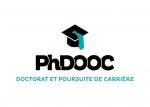 PhDOOC
PhDOOC  Institut Sup'biotech de Paris
Institut Sup'biotech de Paris  TotalEnergies
TotalEnergies  CASDEN
CASDEN 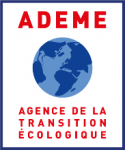 ADEME
ADEME  Généthon
Généthon  CESI
CESI  SUEZ
SUEZ  Tecknowmetrix
Tecknowmetrix  MabDesign
MabDesign  Groupe AFNOR - Association française de normalisation
Groupe AFNOR - Association française de normalisation  ONERA - The French Aerospace Lab
ONERA - The French Aerospace Lab

